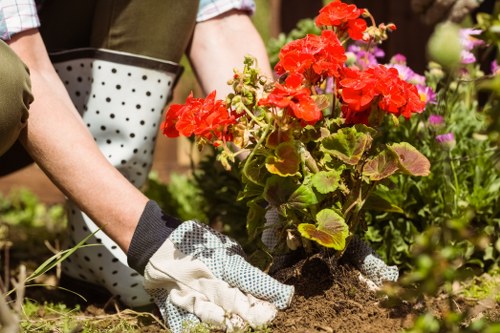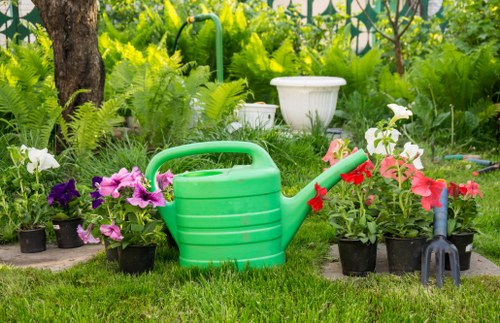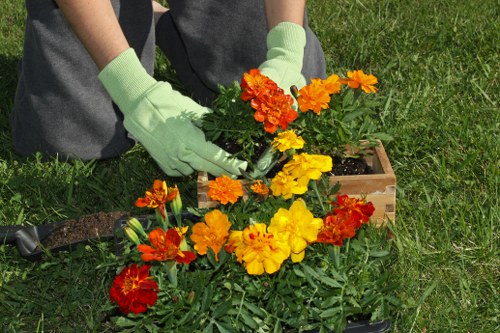Garden Clearance in Local Gardener
Understanding Garden Clearance

Garden clearance is an essential service provided by local gardeners to help homeowners and property managers maintain a tidy and safe outdoor space. Whether you're preparing for a new gardening project, selling your property, or simply decluttering, professional garden clearance can make the process seamless and efficient.
Clearance involves the removal of unwanted plants, debris, old furniture, and other materials that clutter your garden. This not only enhances the aesthetic appeal of your outdoor area but also promotes a healthier environment by reducing the risk of pests and diseases.
Local gardeners are well-equipped with the necessary tools and expertise to handle garden clearance tasks of varying scales. From small residential gardens to large commercial properties, they can tailor their services to meet specific needs.
Benefits of Professional Garden Clearance

Opting for professional garden clearance offers numerous advantages:
- Time-Saving: Clearing a garden can be time-consuming. Professionals complete the task efficiently, allowing you to focus on other priorities.
- Expertise: Experienced gardeners understand the best practices for removing different types of vegetation and debris without causing damage to your property.
- Safety: Handling heavy equipment and large debris can be hazardous. Professionals ensure the job is done safely.
Moreover, garden clearance can significantly increase the value of your property by creating a more appealing and well-maintained outdoor space.
The Garden Clearance Process

The process typically involves several steps to ensure thorough and effective clearance:
- Assessment: The gardener assesses the garden to identify the scope of work required.
- Planning: A clearance plan is developed, outlining the steps and resources needed.
- Execution: Unwanted plants, debris, and other materials are removed systematically.
- Disposal: Proper disposal or recycling of the cleared materials is arranged.
- Final Touches: The garden is tidied up, preparing it for future landscaping or use.
Each step is carried out with attention to detail to ensure the garden is left in pristine condition.
Choosing the Right Local Gardener for Clearance

Selecting the right local gardener is crucial for successful garden clearance. Here are some factors to consider:
- Experience: Look for gardeners with a proven track record in garden clearance.
- Reputation: Check reviews and ask for references to gauge their reliability and quality of work.
- Services Offered: Ensure they provide comprehensive clearance services, including disposal and recycling.
- Pricing: Compare quotes to find a service that offers good value without compromising on quality.
Additionally, a local gardener will have knowledge of regional plant species and environmental regulations, ensuring compliant and effective clearance.
Eco-Friendly Garden Clearance

Environmental responsibility is increasingly important in garden clearance. Many local gardeners adopt eco-friendly practices:
- Recycling Plant Material: Instead of sending green waste to landfills, it can be recycled into compost or mulch.
- Using Sustainable Tools: Electric or battery-powered tools reduce carbon emissions compared to traditional gasoline-powered equipment.
- Selective Clearance: Preserving native plants and biodiversity while removing invasive species.
These practices not only benefit the environment but also contribute to a healthier garden ecosystem.
Cost Factors in Garden Clearance
The cost of garden clearance can vary based on several factors:
- Garden Size: Larger gardens require more time and resources to clear.
- Complexity: Intricate landscapes with hard-to-reach areas may increase the cost.
- Volume of Debris: A higher amount of waste to be removed will affect pricing.
- Additional Services: Extras like soil treatment or plant replacement may add to the total cost.
It's advisable to obtain quotes from multiple local gardeners to ensure competitive pricing and value for money.
Preparing for Garden Clearance
Proper preparation can enhance the efficiency of garden clearance:
- Remove Personal Items: Clear out any personal belongings or valuables from the garden.
- Communicate Preferences: Discuss specific areas to retain or remove with your gardener.
- Accessibility: Ensure that paths and access points are clear for the gardening team to work effectively.
By taking these steps, you facilitate a smoother clearance process and achieve better results.
Post-Clearance Garden Care
After garden clearance, ongoing care is essential to maintain the improved space:
- Regular Maintenance: Schedule periodic upkeep to prevent future clutter and overgrowth.
- Plant Selection: Choose appropriate plants to enhance the garden's beauty and functionality.
- Soil Health: Maintain healthy soil through composting and proper fertilization.
Local gardeners can offer maintenance services to keep your garden in top condition year-round.
Seasonal Considerations in Garden Clearance
Different seasons require specific approaches to garden clearance:
- Spring: Ideal for removing winter debris and preparing beds for planting.
- Summer: Focus on pruning and managing growth to maintain garden health.
- Autumn: Clear fallen leaves and dead plants in preparation for winter.
- Winter: Limited clearance, primarily focused on protecting plants and infrastructure.
Understanding seasonal needs ensures that garden clearance is timely and effective.
Environmental Impact of Garden Clearance
Garden clearance can have significant environmental implications:
- Waste Management: Proper disposal and recycling reduce landfill burden.
- Biodiversity: Preserving native species supports local ecosystems.
- Soil Preservation: Preventing erosion and maintaining soil structure through careful clearance.
Local gardeners play a crucial role in minimizing the environmental impact of garden clearance through sustainable practices.
Hiring Local vs. National Garden Clearance Services
Choosing between local and national services can influence the outcome of your garden clearance:
- Local Expertise: Local gardeners understand regional plant types and climate conditions.
- Community Support: Hiring locally supports the local economy and fosters community relationships.
- Flexibility: Local services may offer more personalized and flexible scheduling options.
- Cost-Effectiveness: Reduced travel costs can make local services more affordable.
Opting for a local gardener ensures tailored services that align with your specific garden needs.
Common Challenges in Garden Clearance
Garden clearance can present several challenges:
- Overgrown Vegetation: Dense growth can be difficult to remove without proper tools.
- Debris Removal: Large amounts of waste require efficient disposal methods.
- Sensitive Plants: Carefully removing unwanted plants without harming desirable ones.
- Accessibility Issues: Navigating tight or uneven spaces can complicate clearance efforts.
Experienced local gardeners are adept at overcoming these obstacles, ensuring a smooth clearance process.
Legal Considerations in Garden Clearance
Garden clearance may involve certain legal aspects:
- Disposal Regulations: Adhering to local laws regarding waste disposal and recycling.
- Protected Species: Ensuring that endangered or protected plants are not removed.
- Property Boundaries: Respecting property lines to avoid disputes.
Local gardeners are typically knowledgeable about these regulations, ensuring compliance during clearance.
Innovative Tools and Techniques
Modern garden clearance employs advanced tools and techniques:
- Mechanical Trimmers: For efficient removal of overgrown vegetation.
- Mulching Machines: To recycle plant material into useful mulch.
- Safety Equipment: Ensuring the protection of both the gardener and the property.
These innovations enhance the effectiveness and safety of garden clearance operations.
Case Studies: Successful Garden Clearances
Examining successful garden clearance projects highlights best practices:
- Residential Makeover: Transforming a cluttered backyard into a serene garden space.
- Commercial Property: Clearing overgrown areas to improve the aesthetic appeal of a business premises.
- Community Gardens: Revitalizing shared spaces for public enjoyment.
These examples demonstrate the positive impact of professional garden clearance.
Maintaining Long-Term Garden Health
Post-clearance maintenance is vital for sustaining garden health:
- Regular Pruning: Keeps plants in shape and promotes growth.
- Weeding: Prevents unwanted plants from taking over.
- Irrigation Management: Ensures plants receive adequate water without wastage.
Local gardeners can provide ongoing maintenance services to keep your garden thriving.
Seasonal Garden Clearance Tips
Adapting garden clearance to seasonal changes optimizes results:
- Spring: Focus on removing winter debris and preparing beds for new plantings.
- Summer: Manage growth through regular pruning and weeding.
- Autumn: Clear fallen leaves and dead plants to prepare for winter.
- Winter: Protect remaining plants and plan for the next gardening season.
Following these tips ensures your garden remains healthy and attractive throughout the year.
Enhancing Curb Appeal with Garden Clearance
A well-cleared garden can significantly boost your property's curb appeal:
- First Impressions: A tidy garden creates a positive first impression for visitors and potential buyers.
- Property Value: Clear and well-maintained gardens can increase the market value of your property.
- Enjoyment: An organized garden provides a pleasant space for relaxation and entertainment.
Investing in professional garden clearance is a wise decision for enhancing your property's overall appeal.
Sustainable Garden Clearance Practices
Promoting sustainability in garden clearance is essential for environmental conservation:
- Composting: Turning organic waste into compost enriches the soil.
- Reusing Materials: Repurposing cleared materials for new garden projects.
- Minimizing Waste: Efficient clearance techniques reduce the overall waste generated.
Adhering to sustainable practices ensures that garden clearance benefits both your property and the environment.
Final Thoughts on Garden Clearance
Garden clearance is a crucial step in maintaining a beautiful and functional outdoor space. By hiring local gardeners, you benefit from their expertise, knowledge of regional conditions, and commitment to quality service.
Whether you're undertaking a complete garden overhaul or regular maintenance, professional clearance services can help you achieve your gardening goals efficiently and sustainably.
Contact us today to schedule your garden clearance and transform your outdoor space into the garden of your dreams. Book your service now and take the first step towards a pristine and enjoyable garden.